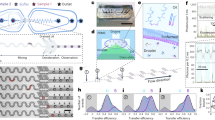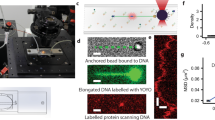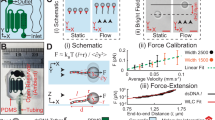Abstract
We describe a high-throughput, automated single-molecule measurement system, equipped with microfluidics. The microfluidic mixing device has integrated valves and pumps to accurately accomplish titration of biomolecules with picoliter resolution. We demonstrate that the approach enabled rapid sampling of biomolecule conformational landscape and of enzymatic activity, in the form of transcription by Escherichia coli RNA polymerase, as a function of the chemical environment.
This is a preview of subscription content, access via your institution
Access options
Subscribe to this journal
Receive 12 print issues and online access
$259.00 per year
only $21.58 per issue
Buy this article
- Purchase on Springer Link
- Instant access to full article PDF
Prices may be subject to local taxes which are calculated during checkout


Similar content being viewed by others
References
Maxwell, K.L. et al. Protein Sci. 14, 602–616 (2005).
Ha, T. et al. Proc. Natl. Acad. Sci. USA 93, 6264–6268 (1996).
Melin, J. & Quake, S.R. Annu. Rev. Biophys. Biomol. Struct. 36, 213–231 (2007).
Squires, T.M. & Quake, S.R. Rev. Mod. Phys. 77, 977–1026 (2005).
Hamadani, K.M. & Weiss, S. Biophys. J. 95, 352–365 (2008).
Hertzog, D.E. et al. Anal. Chem. 76, 7169–7178 (2004).
Lipman, E.A., Schuler, B., Bakajin, O. & Eaton, W.A. Science 301, 1233–1235 (2003).
Pfeil, S.H., Wickersham, C.E., Hoffmann, A. & Lipman, E.A. Rev. Sci. Instrum. 80, 055105 (2009).
Vandelinder, V., Ferreon, A.C., Gambin, Y., Deniz, A.A. & Groisman, A. Anal. Chem. 81, 6929–6935 (2009).
Lemke, E.A. et al. J. Am. Chem. Soc. 131, 13610–13612 (2009).
Hansen, C.L., Sommer, M.O. & Quake, S.R. Proc. Natl. Acad. Sci. USA 101, 14431–14436 (2004).
Ridgeway, W.K., Seitaridou, E., Phillips, R. & Williamson, J.R. Nucleic Acids Res. 37, e142 (2009).
Kapanidis, A.N. et al. Proc. Natl. Acad. Sci. USA 101, 8936–8941 (2004).
Gralla, J.D. & Huo, Y.X. Biochemistry 47, 13189–13196 (2008).
Colyer, R.A. et al. Proc. SPIE 7571, 75710G (2010).
Kapanidis, A.N. et al. Science 314, 1144–1147 (2006).
Unger, M.A., Chou, H.-P., Thorsen, T., Scherer, A. & Quake, S.R. Science 288, 113–116 (2000).
Zimm, B.H., Roe, G.M. & Epstein, L.F. J. Chem. Phys. 24, 279–280 (1956).
Allawi, H.T. & SantaLucia, J. Biochemistry 36, 10581–10594 (1997).
Owczarzy, R. et al. Biochemistry 43, 3537–3554 (2004).
Sugimoto, N. et al. Biochemistry 34, 11211–11216 (1995).
Erickson, D., Li, D. & Krull, U.J. Anal. Biochem. 317, 186–200 (2003).
Majumdar, D.S. et al. Proc. Natl. Acad. Sci. USA 104, 12640–12645 (2007).
Acknowledgements
We thank R. Colyer, P. Blainey and other members of the Weiss and Quake laboratories for helpful discussions. This work was supported by US National Science Foundation Frontiers in Integrative Biological Research grant 0623664 and National Institutes of Health grant GM069709. Fluorescence spectroscopy was performed at the University of California, Los Angeles and California NanoSystems Institute Advanced Light Microscopy and Spectroscopy Shared Facility. A.M.S. was supported by the Stanford University Diversifying Academia, Recruiting Excellence fellowship.
Author information
Authors and Affiliations
Contributions
S.K., A.M.S. and D.S.M. designed experiments, conducted experiments, wrote and implemented data acquisition and analysis software, and analyzed data. R.R.L. analyzed data. S.K., A.M.S., S.R.Q., S.W. and D.S.M. assisted in writing and editing of the manuscript.
Corresponding authors
Ethics declarations
Competing interests
The authors declare no competing financial interests.
Supplementary information
Supplementary Text and Figures
Supplementary Figures 1–10, Supplementary Note 1, Supplementary Table 1 (PDF 918 kb)
Supplementary Software
Software used in this study to control and coordinate microfluidics and optical components. (ZIP 112854 kb)
Rights and permissions
About this article
Cite this article
Kim, S., Streets, A., Lin, R. et al. High-throughput single-molecule optofluidic analysis. Nat Methods 8, 242–245 (2011). https://doi.org/10.1038/nmeth.1569
Received:
Accepted:
Published:
Issue Date:
DOI: https://doi.org/10.1038/nmeth.1569
This article is cited by
-
Direct digital sensing of protein biomarkers in solution
Nature Communications (2023)
-
An automated single-molecule FRET platform for high-content, multiwell plate screening of biomolecular conformations and dynamics
Nature Communications (2023)
-
Nanoliter scale microloop reactor with rapid mixing ability for biochemical reaction
Korean Journal of Chemical Engineering (2018)
-
High-throughput automated microfluidic sample preparation for accurate microbial genomics
Nature Communications (2017)
-
Förster resonance energy transfer and protein-induced fluorescence enhancement as synergetic multi-scale molecular rulers
Scientific Reports (2016)



